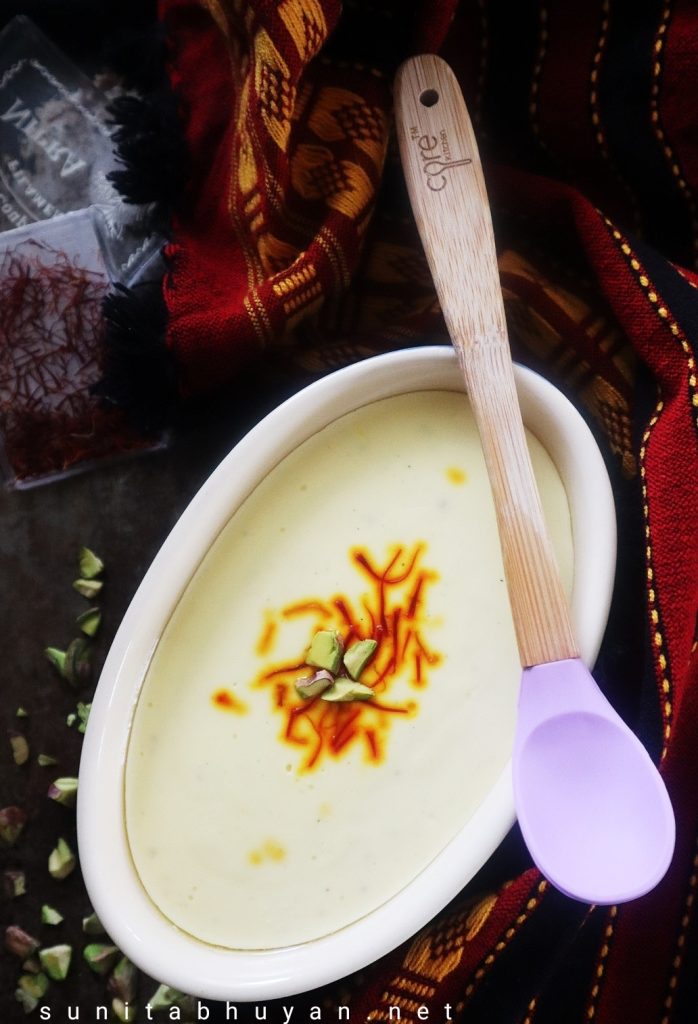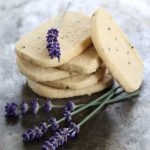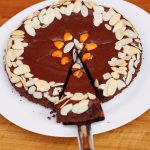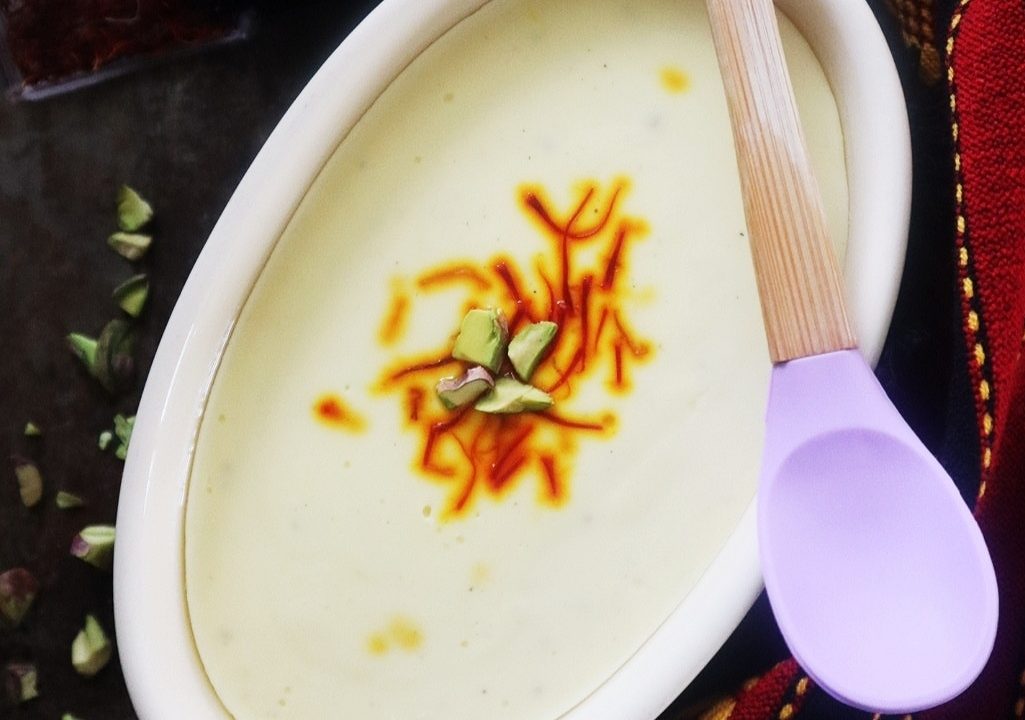This baked saffron yogurt is one of the easiest recipes that you’ll ever make. It has just a few ingredients and is super easy to put together. And then, you just sit back and let the oven and the fridge do the rest of the work. And what you get from the minimum effort is this deliciousness that is full of flavour and yet feels light on the tongue. The garnish of chopped pistachios add a lovely bite.

‘Pujar botor’
‘Pujar botor’…what does that mean…well, for those of us from Assam in North East India, it means the Durga puja season…the season of autumn( sorot kal, as we call it)…. when there is a slight nip in the air…when the sun shines down a bit lazily…when there are smiles all around…people moving to and and fro with that sense of urgency to reach the puja mondop to get a strategic place before it gets over crowded. The one basic aim of this celebration is to propitiate Shakti, the Goddess in Her aspect as Power, to bestow upon man all wealth, auspiciousness, prosperity, knowledge (both sacred and secular), and all other potent powers. The celebration of the goddes Durga’s victory over the demon Mahishasura is a celebration of the victory over all that is evil and of restoring peace and order. Her image is worshipped for nine days and then cast into water. The tenth day is called Bijoya dashami . Processions with Her idol are taken out along the streets of villages and cities.

Memories-
Artisans work day and night to get the idols of the goddess completed for the big and small community pandals. I still remember standing in front of the idol of the goddess with ten hands, astride her lion, striking the demon, and being overcome by a sense of awe and respect (I still am) while taking in the smell of the dhup( incense sticks), dhuna, and lit ghee- filled earthen lamps by the numerous devotees, …somewhat heady, somewhat intoxicating. I remember the priest chanting the scriptures, ringing the tilinga/bell and blowing the songkho / conch as we bowed our heads in front of the deity.
Away from home, my mind still has those vivid pictures of a typical day of the puja festivities when I was kid. We would eagerly look forward to those puja holidays (around 16 days!). We would wake up early in the morning, have a bath, dress up in our puja finery (a.ka. new clothes), drag along with my ma and other ladies from the neighbourhood. The ladies were all dressed in beautiful mekhela sador ( the traditional Assamese attire for women), hands full of offerings for the goddess. Once there, and having paid our respects, while the ladies would sit together and sing ‘durga naam’ (hymns in praise of the goddess). We kids were allowed to wander nearby a bit ( and since there was always someone or the other from our neighbourhood discreetly keeping an eye on us, the mums would not need to worry ).
And that was usually when we would crowd around those vendors selling all those colourful goodies. All the boys and many of the girls almost always had those toy pistols which they fired constantly to let out clouds of smoke and leave that rancid smell in the air( somehow puja was not a puja without those pistols). Then there were those must have fashionable plastic glasses in all the colours imaginable. The balloons of course, especially those tied to a small stick and filled something to make it jingle when shaken, the beads and rings…the sokori /pinwheel which was like the blades of a fan and attached to a stick which one held and ran to make the blades move round and round. It was so much fun. And oh! what about those coloured sweets that one had to have so that one could proudly show around the coloured tongue!
As we approached midday ( especially on mahashtami, the eighth day), the booming sound of the priest over the microphone, calling one and all to hurry up to give anjali (offerings of flowers to the goddess along with the chanting of sloks). As kids, there was a lot of giggling going around as we couldn’t understand all the sloks (chantings) recited in Sanskrit and which we found quite amusing, much to the annoyance of our elders. After the anjali, we would line up for the community meal of khichdi (a rice and lentil dish), ‘labra'( a mixed vegetable of pumpkins, cabbages, potatoes, aubergines, moolees), sometimes with ‘bilahir tok'(a tomato chutney) and always followed by ‘payash'(rice pudding)… a very simple meal but utterly divine… In the evenings, people would dress up in their puja finery and go pandal hopping…to see the various idols in the numerous pandals. Some of the pandals, even managed to offer special effects to the idols… definite crowd pullers. And for the kids, more balloons and fun stuff!
On the tenth day, the idols are taken out in processions through the streets and then submerged into the river…marking the end of the ten day festivities…this is Bijoya Dashami. It is traditional to have sweets on this day, especially jalebis…and deuta(my father) would bring those from the famous sweet shop near our house, whose sweetmakers worked overtime trying to meet the demands of the never ending queue of customers. As kids, dashami just meant that we get to have loads of these warm, freshly prepared jalebis, licking our sticky hands.
But, times have changed though; and the weather definitely has! Gone are the days of our childhood when we used to wake up to misty autumnal mornings during Durga Puja! During my phone call with ma yesterday, she mentioned the heat- temperatures were hovering over 37 deg C; apparently one of the hottest days in October, ever! However, back in Assam, however hot the weather, the spirit of Durga Puja is definitely still present. As for us, the temperatures have definitely dipped in our neck of the woods and autumn has truly set in. And I feel lucky to get the same feeling of waking up as a child to the nip in the air!
As the years passed, Bijoya dashami became even more special for me as I got married on one dashami day. Just like the goddess, I too left for my husband’s abode on one such day (it is said that the goddess goes to visit her mother during this period and returns to her husband after nine days, on dashami.).
Today is Dashami, and while we will not be gorging on sticky jalebis, I did make some baked saffron yogurt to sweeten the occasion!
Substitutes-
I used Greek yogurt to make this baked saffron yogurt. If it is not readily available where you live, you can use strained natural yogurt. After straining the natural yogurt of the excess whey, measure and add 1 and 1/4 cups as required by the recipe.
Continue reading for the full, printable recipe for this easy to make yet delicious baked saffron yogurt.

Subscribe to Sunita’s World – life and food! to receive updates on latest posts, tips and recommendations straight to your inbox! Simply fill in the details below. Thank you!
Recipe card-

Baked saffron yogurt
Ingredients
- 1¼ cup Greek yogurt (see notes below)
- ¼ cup condensed milk
- a small pinch of saffron strands, soaked in 2 tbsp of warm milk and cooled
- ¾ tsp crushed cardamom seeds
For garnishing
- Chopped pistachio nuts
- a few strands of saffron
Instructions
- Pre heat the oven at 180 deg C
- In a bowl, add the yogurt, condensed milk and saffron milk and whisk together.
- Add the crushed cardamom and whisk well.
- Tip the yogurt mixture to an ovenproof dish and tap the dish gently on the counter.
- Arrange a few strands of saffron on top (around the centre).
- Cover the dish with a piece of aluminium foil.
- Take a baking dish (bigger than the one you are baking the yogurt in) and add some water in it.
- Place the baking dish with the yogurt in the bigger dish. The water should come up to about a quarter of the way up. At this stage, add more water if needed to come up to the desired level.
- Place the dish in the centre of the pre heated oven and bake for 50 minutes.
- Remove from the oven and carefully take the dish out of the water bath.
- Remove the foil and bring to room temperature.
- Chill for at least four hours or overnight before serving.
- To serve, spoon the yogurt into bowls and add some chopped pistachios on top.
Video
Notes
- I used Greek yogurt to make this baked saffron yogurt. If it is not readily available where you live, you can use strained natural yogurt. After straining the natural yogurt of the excess whey, measure and add 1 and 1/4 cups as required by the recipe.
All the baking recipes on this website can be found here.
You might also like these other recipes from this website-



Until next time,
Sunita
STAY CONNECTED:
